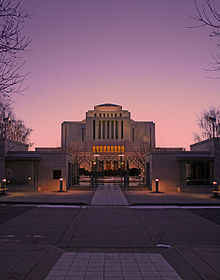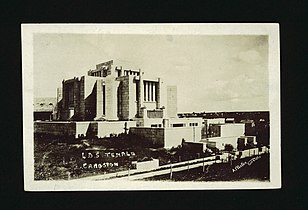| Cardston Alberta Temple | ||||
|---|---|---|---|---|
 | ||||
 | ||||
| Number | 6 | |||
| Dedication | August 26, 1923, by Heber J. Grant | |||
| Site | 10 acres (4.0 ha) | |||
| Floor area | 88,562 sq ft (8,227.7 m2) | |||
| Height | 85 ft (26 m) | |||
| Official website • News & images | ||||
| Church chronology | ||||
| ||||
| Additional information | ||||
| Announced | June 27, 1913, by Joseph F. Smith | |||
| Groundbreaking | November 13, 1913, by Daniel Kent Greene | |||
| Open house | Tours offered, 1920–23 June 6–15, 1991 (after renovation) | |||
| Rededicated | July 2, 1962, by Hugh B. Brown June 22, 1991, by Gordon B. Hinckley | |||
| Current president | F. Brent Thomas[1] | |||
| Designed by | Hyrum Pope and Harold W. Burton | |||
| Location | Cardston, Alberta, Canada | |||
| Geographic coordinates | 49°11′52.23840″N 113°18′32.50800″W / 49.1978440000°N 113.3090300000°W | |||
| Exterior finish | White granite | |||
| Baptistries | 1 | |||
| Ordinance rooms | 4 (four-stage progressive) | |||
| Sealing rooms | 5 | |||
| Clothing rental | Yes | |||
| Visitors' center | Yes | |||
| Notes | An addition was completed in 1962 and was dedicated on July 2, 1962 by Hugh B. Brown. | |||
| () | ||||
| Cardston Alberta Temple | |
|---|---|
| Location | Cardston, Southern Alberta, Alberta, Canada |
| Area | 10 acres (40,000 m2) |
| Founded | June 27, 1913 |
| Built | 1913–1923 |
| Architectural style(s) | LDS temple |
| Governing body | The Church of Jesus Christ of Latter-day Saints |
| Website | Official LDS Cardston Alberta Temple page |
| Designated | 1992 |
The Cardston Alberta Temple (formerly the Alberta Temple) is a temple of the Church of Jesus Christ of Latter-day Saints in Cardston, Alberta. It was the eighth temple constructed and is the sixth still in operation. The intent to build the temple was announced on October 12, 1912, by church president Joseph F. Smith, during the church's general conference. The Cardston Alberta Temple was the first temple built in Canada and the first built outside the United States. It is the fourth temple in the province of Alberta and is one of ten operated by the church in Canada. It is one of two temples built in the shape of a cross, the other being the Laie Hawaii Temple.
The temple's distinctive cross shape, and absence of spires are defining characteristics that set it apart, and this design brought the church into the modern age of architecture. The temple was crafted by Harold W. Burton and Hyrum Pope, drawing inspiration from American architect Frank Lloyd Wright. Their design was unique in use of geometric decorative elements, and with integration of the surrounding natural environment. A groundbreaking ceremony was held on November 9, 1913. With the church's focus on sacred spaces, the Cardston Alberta Temple reflects its deep-rooted commitment to spiritual practices and community enrichment.
The history of the Cardston Alberta Temple began with its announcement by church president Joseph F. Smith on October 12, 1912. The site for the temple was selected due to its significance to the church and the local community. It was built on an eight-acre plot named Tabernacle Block.[2] The plot was given to the church by Charles Ora Card.
In 1992, the temple was declared a National Historic Site, and a plaque was dedicated in 1995.[3]
A groundbreaking ceremony took place on November 9, 1913, marking the commencement of construction. This ceremony was presided over by Joseph F. Smith, and attended by local church members and community leaders.[2]
During the construction phase, the temple faced various challenges, including delayed construction due to World War I. The construction of the temple took a total of 10 years, with the final two years dedicated to interior furnishing and preparation for public use.[4]
As the construction of the temple began, the Relief Society General Board started a penny subscription. They saved a penny each week, allowing them to contribute more than $13,000 to the construction of the Cardston Alberta and Laie Hawaii temples.[5]
The Cardston Alberta Temple was dedicated on August 26, 1923, by church president Heber J. Grant.[2][6] The site expanded to more than 10 acres (4.0 ha) in the mid-1950s.
Throughout its history, the temple has served as a center of spiritual growth and community activities, playing a vital role in the lives of church members in the region.
Originally dedicated on August 26, 1923, by Grant,[7] an addition was dedicated on July 2, 1962, by Hugh B. Brown. The first temple president was Edward J. Wood, who served from 1923 to 1948. The temple was renovated in the 1990s, with Gordon B. Hinckley rededicating it on June 22, 1991.
In 2020, like all the church's other temples, the Cardston Alberta Temple was closed for a time in response to the coronavirus pandemic.[8]
The architectural style of the Cardston Alberta Temple is characterized by a fusion of Grecian and subtle Peruvian influences, resembling designs of Aztec temples with traditional temple designs by the church.[9] Designed by Hyrum Pope and Harold W. Burton, the temple's architecture reflects both the cultural heritage of the town of Cardston and the spiritual significance of the church. Inspired by the designs of architect Frank Lloyd Wright, the temple embodies a fusion of Mayan-Aztec and Prairie School architectural styles.[10] The granite used in building the temple was hand-hewn from quarries in Nelson, British Columbia.
The temple has four ordinance rooms, five sealing rooms, and a floor area of 88,562 square feet (8,227.7 m2). Spanning an area of 81,700 square feet (7,590 m2) on 10 acres of land and is constructed with white granite sourced from a quarry near Kootenai Lakes in Nelson, British Columbia. The exterior features a singular central tower with a pyramid roof, hand-shaped stone, and stained-glass windows, while the interior consists of woods and materials imported from all over the world, hand-painted murals, and a sculpted water feature.[6][11]
One of the focal points of the Cardston Alberta Temple is the placement at the town’s central square, enclosed within a stone wall and views of Chief Mountain. Its octagonal shape under a pyramidal capped roof and Greek cross layout with arms facing cardinal directions are distinct features that symbolize its historical significance.[12]
Incorporated into the design are symbolic elements from the Bible, which provide deeper spiritual meaning to the temple's appearance and function. Symbolism is an important subject to members of the church. The temple is situated on top of a small hill with prairies. The landscaping around the temple features large trees, flower gardens, and paved walkways surrounding the temple.
Other than Wood, other notable temple presidents, or matrons, include Merlin R. Lybbert (1994–97); Elaine L. Jack (1997–2000); and Ardeth G. Kapp (2000–03).
